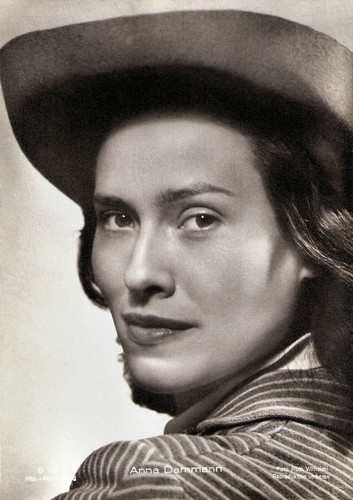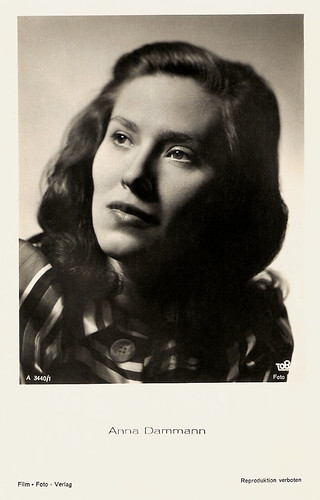Beautiful Anna Dammann (1912-1993) was one of the major theatre actresses of Germany in the 20th Century. In 1932 she debuted on the stage as Brunhild in Friedrich Hebbel’s 'Die Nibelungen' and would go on to play leading roles in many famous classic and modern plays. Sadly she appeared only in a few, not very outstanding films.

German postcard by Film-Foto-Verlag, no. A 3893/1, 1941-1944. Photo: Ruth Wilhelmi.

German postcard by Film-Foto-Verlag, no. G 162. Photo: Ruth Wilhelmi.
Anna Dammann was born Edith Geese in Altona (now Hamburg), Germany, in 1912. She attended a high school for girls and from 1930 to 1932 she had acting lessons from Albrecht Schoenhals.
After theatre engagements in Frankfurt an der Oder, Wuppertal, Stuttgart and Düsseldorf, she came to work at the Deutsche Theater in Berlin in 1937. Till 1945, she played many classic female roles like Antigone, Mary Stuart, Cassandra, Cleopatra and The Maid of Orleans.
Her first film was Oberwachtmeister Schwenke (Carl Froelich, 1935) starring Gustav Fröhlich.
Her next appearance was as the city girl in Die Reise nach Tilsit/The Trip to Tilsit (Veit Harlan, 1939) who lures fisherman Frits van Dongen (aka Philip Dorn) away from his wife, Kristina Söderbaum. It was her first leading part.
This sound remake of F.W. Murnau's classic silent film Sunrise (1927) was a far more earthy, darker and more realistic adaptation of the short story by Hermann Sudermann. It was shot in Memel, where the action takes place.

German postcard by Film-Foto-Verlag, no. A 3780/1, 1941-1944. Photo: Ruth Wilhelmi.

German postcard by Ross Verlag, no. A 2534/1, 1941-1944. Photo: Baumann / Terra.
Anna Dammann next starred in Johannisfeuer/St. John's Fire (Arthur Maria Rabenalt, 1939) with Ernst von Klipstein.
Dammann appeared in the propaganda film Mein Leben für Irland/My Life for Ireland (Max W. Kimmich, 1941) with René Deltgen. The film covered a story of Irish heroism and martyrdom over two generations under the occupation of the evil British. Mein Leben für Irland was produced for Nazi-occupied Europe with the intent of challenging pro-British allegiances. However, Wikipedia writes that instead, audiences identified the Irish struggle with their own resistance against the Nazis.
During the war years, she also starred in Nacht ohne Abschied/Night Without Goodbye (Erich Waschneck, 1943) with Karl Ludwig Diehl, and Gefährtin meines Sommers/My Summer Companion (Fritz Peter Buch, 1943) opposite Paul Hartmann.
After WWII, she played merely on stage. She appeared in only one more film, under the name Anna Dannemann in Oberarzt Dr. Solm/Senior Physician Dr. Solm (Paul May, 1955) with Hans Söhnker. Incidentally, she appeared on television, like in Die Troerinnen des Euripides/The Trojan Women of Euripides (Paul Verhoeven, 1959).
Anna Dammann died in 1993 in Munich, Germany. She was married to businessman and art researcher Walter Geese with whom she had a daughter.

German postcard by Ross Verlag, no. A 3388/1, 1941-1944. Photo: Binz / Tobis.

German postcard by Film-Foto-Verlag, no. A 3440, 1941-1944. Photo: Binz / Tobis.
Sources: Stephanie d'Heil (Steffi-line.de) (German), Thomas Staedeli (Cyranos), Wikipedia (German and English) and IMDb.
This post was last updated on 22 November 2023.

German postcard by Film-Foto-Verlag, no. A 3893/1, 1941-1944. Photo: Ruth Wilhelmi.

German postcard by Film-Foto-Verlag, no. G 162. Photo: Ruth Wilhelmi.
City girl
Anna Dammann was born Edith Geese in Altona (now Hamburg), Germany, in 1912. She attended a high school for girls and from 1930 to 1932 she had acting lessons from Albrecht Schoenhals.
After theatre engagements in Frankfurt an der Oder, Wuppertal, Stuttgart and Düsseldorf, she came to work at the Deutsche Theater in Berlin in 1937. Till 1945, she played many classic female roles like Antigone, Mary Stuart, Cassandra, Cleopatra and The Maid of Orleans.
Her first film was Oberwachtmeister Schwenke (Carl Froelich, 1935) starring Gustav Fröhlich.
Her next appearance was as the city girl in Die Reise nach Tilsit/The Trip to Tilsit (Veit Harlan, 1939) who lures fisherman Frits van Dongen (aka Philip Dorn) away from his wife, Kristina Söderbaum. It was her first leading part.
This sound remake of F.W. Murnau's classic silent film Sunrise (1927) was a far more earthy, darker and more realistic adaptation of the short story by Hermann Sudermann. It was shot in Memel, where the action takes place.

German postcard by Film-Foto-Verlag, no. A 3780/1, 1941-1944. Photo: Ruth Wilhelmi.

German postcard by Ross Verlag, no. A 2534/1, 1941-1944. Photo: Baumann / Terra.
Anti-British propaganda
Anna Dammann next starred in Johannisfeuer/St. John's Fire (Arthur Maria Rabenalt, 1939) with Ernst von Klipstein.
Dammann appeared in the propaganda film Mein Leben für Irland/My Life for Ireland (Max W. Kimmich, 1941) with René Deltgen. The film covered a story of Irish heroism and martyrdom over two generations under the occupation of the evil British. Mein Leben für Irland was produced for Nazi-occupied Europe with the intent of challenging pro-British allegiances. However, Wikipedia writes that instead, audiences identified the Irish struggle with their own resistance against the Nazis.
During the war years, she also starred in Nacht ohne Abschied/Night Without Goodbye (Erich Waschneck, 1943) with Karl Ludwig Diehl, and Gefährtin meines Sommers/My Summer Companion (Fritz Peter Buch, 1943) opposite Paul Hartmann.
After WWII, she played merely on stage. She appeared in only one more film, under the name Anna Dannemann in Oberarzt Dr. Solm/Senior Physician Dr. Solm (Paul May, 1955) with Hans Söhnker. Incidentally, she appeared on television, like in Die Troerinnen des Euripides/The Trojan Women of Euripides (Paul Verhoeven, 1959).
Anna Dammann died in 1993 in Munich, Germany. She was married to businessman and art researcher Walter Geese with whom she had a daughter.

German postcard by Ross Verlag, no. A 3388/1, 1941-1944. Photo: Binz / Tobis.

German postcard by Film-Foto-Verlag, no. A 3440, 1941-1944. Photo: Binz / Tobis.
Sources: Stephanie d'Heil (Steffi-line.de) (German), Thomas Staedeli (Cyranos), Wikipedia (German and English) and IMDb.
This post was last updated on 22 November 2023.
No comments:
Post a Comment